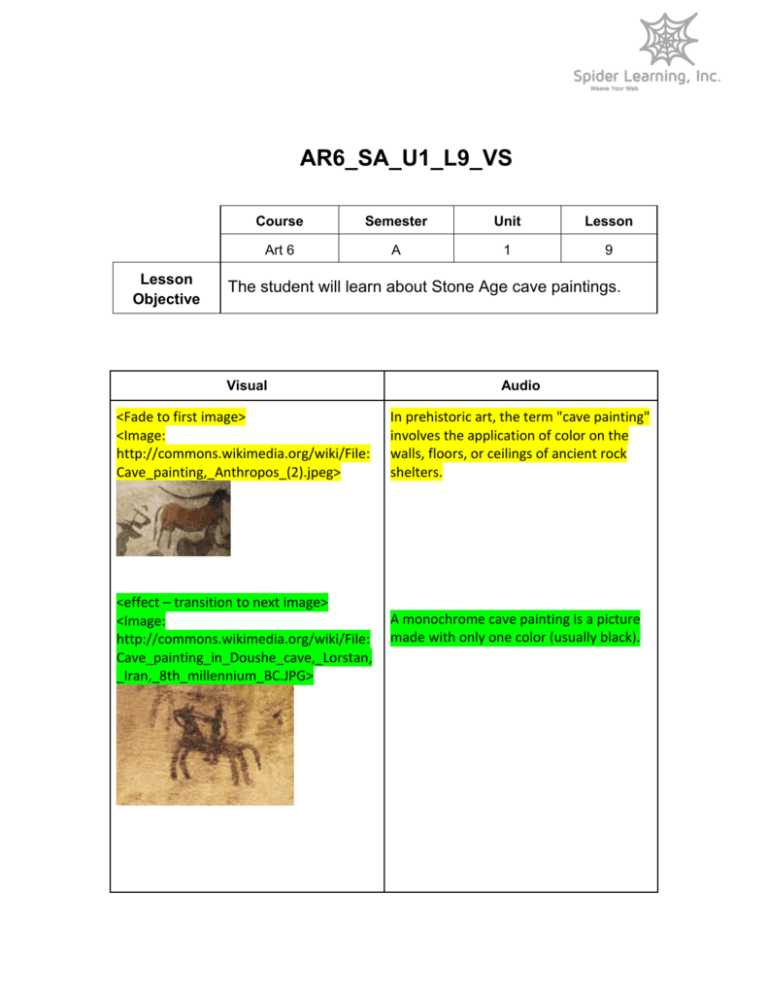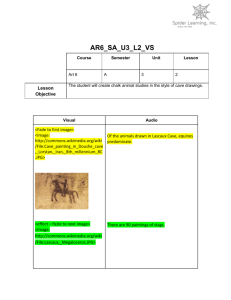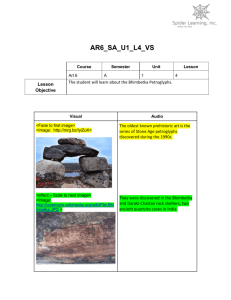AR6_SA_U1_L9_VS
advertisement

AR6_SA_U1_L9_VS Lesson Objective Course Semester Unit Lesson Art 6 A 1 9 The student will learn about Stone Age cave paintings. Visual Audio <Fade to first image> <Image: http://commons.wikimedia.org/wiki/File: Cave_painting,_Anthropos_(2).jpeg> In prehistoric art, the term "cave painting" involves the application of color on the walls, floors, or ceilings of ancient rock shelters. <effect – transition to next image> <Image: http://commons.wikimedia.org/wiki/File: Cave_painting_in_Doushe_cave,_Lorstan, _Iran,_8th_millennium_BC.JPG> A monochrome cave painting is a picture made with only one color (usually black). <effect – fade to image> <Image: http://commons.wikimedia.org/wiki/File: Cave_painting,_Anthropos_(2).jpeg> A polychrome cave painting consists of two or more colors. We have no firm idea when cave painting <effect – fade to image> first began. <image: http://commons.wikimedia.org/wiki/File: Paintings_from_the_Chauvet_cave_(muse um_replica).jpg> <effect – fade to image> <Image: http://commons.wikimedia.org/wiki/File: Cave_painting,_Anthropos_(1).jpeg> One theory links the evolution of Stone Age art to the arrival of anatomically modern humans in Europe. It was from about this date that the <effect – fade to image> earliest rock art began to emerge in the <Image: http://commons.wikimedia.org/wiki/File:L caves and rock shelters. ions_painting,_Chauvet_Cave_(museum_r eplica).jpg> <effect – fade to image> <Image: http://commons.wikimedia.org/wiki/File: Pech_Merle_cave_leopard_spotting.JPG> Cave painting techniques and materials improved across the board, century by century. <effect – cross dissolve to image, display on white background> <image: http://commons.wikimedia.org/wiki/File: Kapova.png> Let’s explore how these works of art were created in the Stone Age. <effect – fade to text, display as audio is read> <TEXT displayed in bold, bright colors text that will be the title to first section: The majority of prehistoric cave paintings were of animals. Subject Matter <effect – transition to image> <Image: http://commons.wikimedia.org/wiki/File: Cave_painting__National_Museum_of_Mongolian_Histor y.jpg> At first, Stone Age artists painted predator animals. <effect – cross dissolve to image, display on white background> <Image: http://commons.wikimedia.org/wiki/File: Men_of_the_old_stone_age_(1915)_Wolf .png> Later on, game animals dominated the imagery. <effect – fade to image> <Image: http://mrg.bz/2yEelu> Pictures of humans were an exceptionally rare occurrence. <effect – transition to text> <image: http://mrg.bz/QDIRBI> Abstract imagery was also common, and actually comprises the oldest type of Paleolithic art found in caves. <effect – fade to image> <Image: http://mrg.bz/djP3Xy> Prehistoric caves are also heavily decorated with painted hand stencils, most of which were made by females, but men and children were also involved. <effect – fade to text> <TEXT: display in large, bold, brightly colored text that will be the title to first section: Prehistoric artists employed a wide variety of painting methods. Painting Methods <effect – transition to next image> <Image: http://mrg.bz/MlXP1j> <effect – cross dissolve to next image> <image: http://commons.wikimedia.org/wiki/File:F inger_Painting.jpg> They used sea-shells as paint containers and worked by candlelight, or occasionally weak sunlight. Initially, they painted with their fingers. <effect – fade to image> <image: http://mrg.bz/fRhwLp> Later, they switched to lumpy pigment crayons, pads of moss, or brushes made of animal hair or vegetable fiber. <effect – fade to image> <image: http://mrg.bz/Gc8zhB> They also employed spray painting techniques using reeds or specially hollowed bones. <effect – transition to text> <image: http://mrg.bz/LOxnWP> Stone Age painters also used foreshortening, or distortion, and chiaroscuro techniques. <effect – cross dissolve to next image> <Image: http://mrg.bz/P0cwOa> Foreshortening occurs when an object appears compressed when seen from a particular viewpoint. <effect – fade to image> <Image: http://mrg.bz/Gn2oyT> <effect – fade to image> <image: http://mrg.bz/SQIuxR> <Fade to first image> <Image: http://mrg.bz/8oRiDx> This effect of perspective causes distortion. Foreshortening is a particularly effective artistic device. It is used to give the impression of threedimensional volume and creates drama in a picture. <effect – cross dissolve to next image> <Image: http://mrg.bz/Y60DZf> Chiaroscuro is the use of strong contrasts between light and dark, usually bold contrasts. <effect – fade to image> <Image: http://mrg.bz/z7C4dW> It is also a technical term for the use of contrasts of light to achieve a sense of volume. <effect – fade to image> <image: http://commons.wikimedia.org/wiki/File: Post-Dynamic_figure_panel__Google_Art_Project.jpg> Each era introduced new cave painting methods, and caves decorated over many generations exhibit numerous styles. <effect – fade to text> <TEXT: display as large, bold, brightly colored text that will be the title to this section: All pigments used in cave painting were sourced locally, mostly from mineral deposits found in the Earth. Paints and Pigments <effect – fade to image> <Image: http://mrg.bz/wdiCv8> Stone Age painters employed several different combinations of materials to make colored paints. <effect – fade to image> <Image: http://mrg.bz/ZQkSFn> <effect – fade to image> <Image: http://mrg.bz/TL5gvd> Clay ochre provided three basic colors: numerous varieties of red, plus yellow and brown. For black color, artists used either manganese dioxide or charcoal. <effect- fade to image> <image: http://mrg.bz/A63hIP> After grinding the pigments to fine powder, artists mixed the powder with cave water, animal fats, vegetable juice, or blood to help it stick to the rock surface. <effect- fade to image> <Image: http://mrg.bz/WPBLNw> Artists were familiar with pigments through body painting and face painting, which they were practicing long before they started decorating caves. <effect – fade to image, display on white background> <image: http://commons.wikimedia.org/wiki/File: PSM_V83_D022_Male_and_female_bison _modeled_in_clay.png> As you can see, the creative process of the Stone Age artist continues to be both innovative and inspiring.







